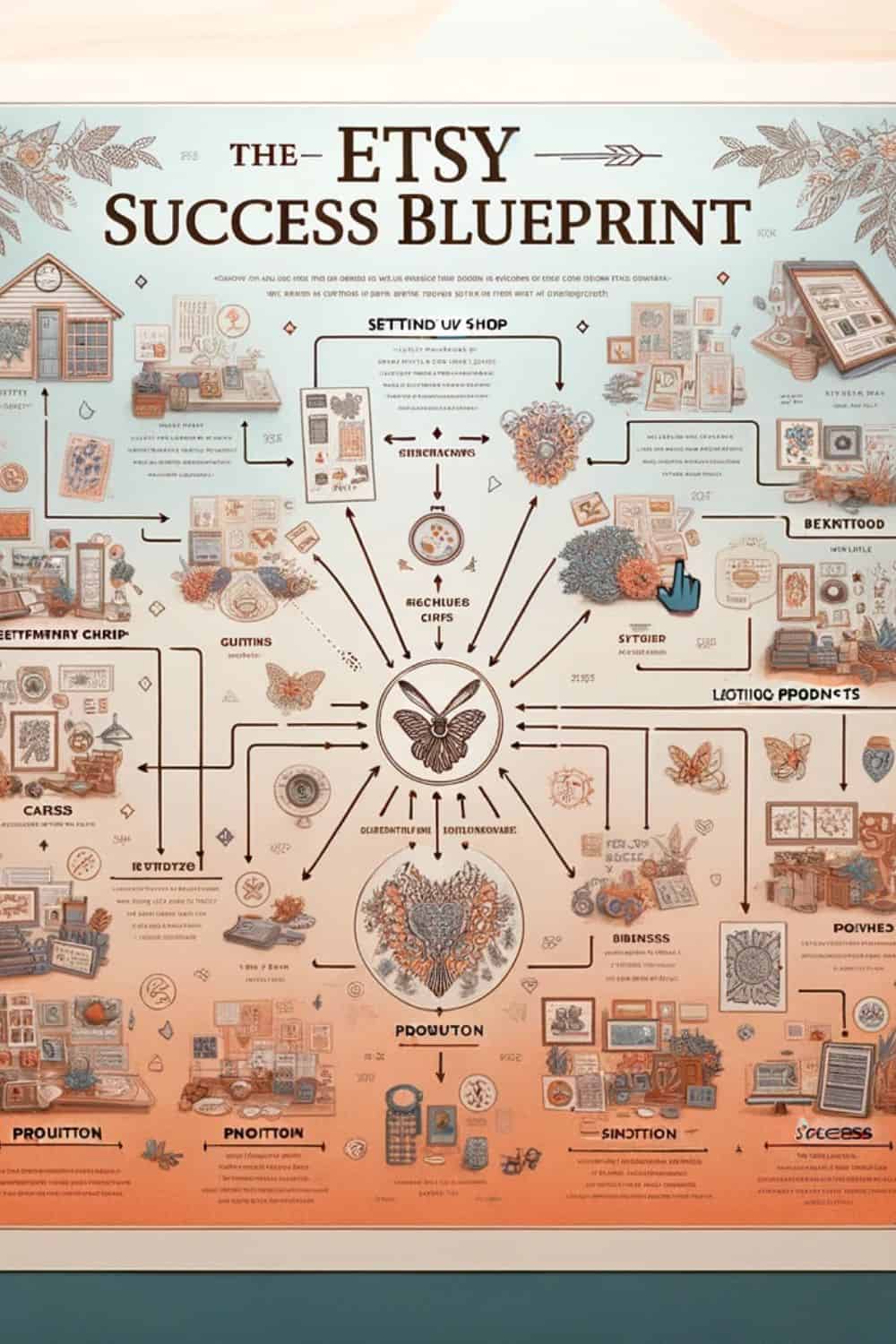In the vast world of online business, platforms like Etsy have carved a niche for themselves, becoming a beacon for artists, handmade business owners, and craft enthusiasts. For many, Etsy is synonymous with unique, handcrafted items, vintage treasures, and art that speaks to the soul. Yet, despite its popularity and the success stories we often hear, there’s a cloud of misconceptions surrounding the platform. Many potential Etsy sellers are held back by myths and misunderstandings, questioning the viability of the platform as a genuine source of income.
One common misconception is the perceived difficulty of selling on Etsy. The narrative that it’s an oversaturated market, too challenging for newcomers, or that only a select few achieve real success is prevalent. But is this really the case? As we delve deeper into the world of Etsy, we’ll uncover the truths and debunk the myths. We’ll explore the potential of the platform, not just as an online marketplace, but as a community of passionate creators and eager buyers.
For artists who sell their art, the allure of Etsy is undeniable. It offers a platform where their creations can shine, reaching potential customers from all corners of the globe. Similarly, for those who frequent craft fairs, the transition to an online platform like Etsy can open doors to a wider audience, without the geographical constraints of physical locations.
Handmade business owners, too, find a home on Etsy. The platform celebrates the uniqueness of handmade goods, offering a space where craftsmanship is valued and sought after. With the right strategies, understanding the nuances of search engines, and crafting compelling product listings, sellers can tap into a vast pool of active buyers, eager to support and purchase handmade items.
Yet, as with any venture, success on Etsy requires more than just listing items and waiting for sales. It’s about understanding the platform, the audience, and the market. It’s about leveraging tools like Etsy ads, optimizing for search results, and ensuring that every interaction, from product descriptions to customer service, resonates with authenticity and passion.
As we embark on this exploration, remember that Etsy is more than just a platform; it’s a community. A community of creators, dreamers, and buyers, all connected by a shared love for the unique and the handcrafted. And within this community lies a world of potential, waiting to be tapped by those willing to look beyond the myths and see the opportunities that lie ahead.

Finally! A Proven Way To Actually Grow Your Audience Of True Fans Without Making Social Media A Full Time Job
Understanding Etsy’s Popularity
In the ever-evolving landscape of e-commerce, Etsy has emerged as a dominant force, particularly for those in the realm of handmade goods, art, and vintage finds. But what is it about this platform that has garnered such widespread appeal? At its core, Etsy’s success can be attributed to its unique positioning as a leading online marketplace tailored specifically for creators, artisans, and vintage enthusiasts.
Etsy isn’t just another selling platform; it’s a curated space where individuality shines, and authenticity is celebrated. For artists who sell their art, Etsy offers a platform where their creations aren’t just products but stories waiting to be shared. Every painting, sculpture, or handcrafted jewelry piece tells a tale, and Etsy provides the stage for these narratives to reach eager audiences.
Handmade business owners find solace in Etsy’s ethos. In a world dominated by mass production, there’s a growing appetite for items that carry a personal touch, a hint of nostalgia, or a story of craftsmanship. Etsy taps into this desire, connecting handmade business owners with potential customers who value the time, effort, and creativity that goes into each product.
For those who’ve spent weekends at craft fairs, setting up stalls, and interacting with customers face-to-face, Etsy offers a digital extension of that experience. It’s a space where the charm of craft fairs meets the vast reach of the internet, allowing sellers to showcase their creations to a global audience, 24/7.

The Power of a Niche Marketplace
In the vast world of online shopping, where giants like Amazon and eBay reign supreme, one might wonder how a niche platform like Etsy manages to hold its ground. The answer lies in its unwavering focus on handmade goods, art, and unique items.
While other platforms cater to a broad spectrum of products and services, Etsy has carved out a space specifically for creators and artisans. This specialization is its strength. On Etsy, a hand-knitted scarf isn’t just another item in a catalog; it’s a labor of love, a testament to an artisan’s skill, and a unique piece that carries its own identity.
Furthermore, Etsy’s community-driven approach fosters a sense of belonging. Sellers aren’t just vendors; they’re part of a larger community of like-minded individuals who share a passion for creativity. This community-centric vibe resonates with buyers too, many of whom are drawn to Etsy not just for the products but for the stories, the people, and the ethos the platform embodies.
In essence, Etsy’s popularity isn’t just about numbers or sales. It’s about the connections it facilitates, the stories it helps tell, and the space it provides for creativity to flourish.
Breaking Down the Etsy Selling Process
Embarking on the Etsy journey can be both exhilarating and daunting. For many artists and handmade business owners, the platform offers a world of possibilities, but where does one begin? Let’s demystify the Etsy selling process, guiding you through the essential steps to set up a thriving shop.
Setting Up Your Shop
The foundation of any successful Etsy shop lies in its identity. Your shop name is the first impression potential customers will have of your brand. It should resonate with your products, your ethos, and, most importantly, be memorable. Think of names that evoke emotions, paint pictures, or tell stories. Remember, in the vast sea of Etsy sellers, a catchy shop name can set you apart.
Once you’ve settled on a name, it’s time to dive into the nitty-gritty: understanding the listing fees. Etsy charges a nominal fee for each item you list. While this might seem like an added expense, think of it as an investment. It’s a small price to pay for the visibility and reach the platform offers.
But what’s visibility without allure? This is where high-quality photos come into play. In an online marketplace, your product photos are the equivalent of a shop window display at a craft fair. They need to captivate, entice, and offer a glimpse into the craftsmanship of your handmade items. Invest time in capturing well-lit, clear, and appealing images. Remember, a picture speaks a thousand words, especially on Etsy.
Crafting Compelling Product Descriptions
Once your photos have caught the eye of potential customers, your product descriptions seal the deal. These aren’t just bland specifications; they’re narratives. Share the story behind each handmade item, the inspiration, the materials, the process. Make it personal. Let potential buyers feel the passion and effort that went into creating each piece.
Of course, while storytelling is essential, don’t forget the practical details. Size, care instructions, and other specifics are crucial for buyers to make informed decisions. Striking a balance between the emotive and the practical is the key to compelling product descriptions.
Leveraging Etsy Ads and Etsy Plus
Visibility on Etsy isn’t just about stellar photos and captivating descriptions. With the platform’s promotional tools, you can give your shop an added boost. Etsy Ads, for instance, allow you to promote your listings, ensuring they appear in prominent positions in search results. It’s a way to get your products in front of a larger audience, increasing the chances of sales.
For those looking to take their Etsy journey a notch higher, Etsy Plus offers a suite of advanced tools. From restocking alerts to custom web addresses, it’s designed to give sellers an edge, enhancing the shop’s professionalism and appeal.
In essence, while Etsy offers a platform, the magic lies in how you use it. With the right strategies, a sprinkle of creativity, and a dash of business acumen, the Etsy selling process can be both rewarding and fulfilling.
The Financial Aspect: Understanding Fees and Profit Margins
Navigating the financial intricacies of an online marketplace can often feel like a daunting task, especially for artists and handmade business owners who are more attuned to the creative process than the nitty-gritty of numbers. However, understanding the financial dynamics of Etsy is crucial for anyone looking to turn their passion into a profitable venture. Let’s delve into the various fees associated with selling on Etsy and explore strategies to ensure healthy profit margins.
Decoding the Transaction and Listing Fees
At the heart of Etsy’s financial structure are the transaction and listing fees. Every time you list an item on Etsy, a small listing fee is incurred. Think of this as the cost of showcasing your product on a global platform, much like renting a stall at a craft fair, but with the potential to reach millions of potential customers.
Then comes the transaction fee, which is a percentage of the sale price once an item is sold. This fee covers the platform’s role in facilitating the sale, from hosting your shop to processing payments. While these fees might seem like additional expenses, it’s essential to view them in the broader context of business operations. Just as a brick-and-mortar store incurs rental and utility costs, online sellers have platform-specific expenses.
To ensure healthy profit margins, it’s crucial to factor in these fees when pricing items. Consider the cost of materials, labor, and other overheads, and then add the Etsy fees. This comprehensive approach ensures that you not only cover your costs but also earn a fair profit for your efforts.

The Debate: Free Shipping vs. Shipping Fees
Shipping is another critical aspect of the Etsy selling process, and it often sparks a debate among sellers: to offer free shipping or not? On the surface, free shipping might seem like a surefire way to attract potential buyers. After all, who doesn’t love a good deal? However, there’s more to this decision than meets the eye.
Offering free shipping can indeed be a powerful incentive for potential customers, making your products more appealing in search results. However, the costs associated with shipping don’t just vanish. They need to be absorbed somewhere, often leading sellers to incorporate them into the product price.
On the other hand, being transparent about shipping fees allows customers to understand the true cost of the product and the logistics behind delivering it to their doorstep. It’s a more straightforward approach, but it might deter some buyers who are particularly sensitive to shipping costs.
The decision ultimately boils down to understanding your target audience and market research. For some products and demographics, free shipping might be the golden ticket, while for others, transparency and clarity might hold more value.
In the end, the financial journey on Etsy is as much about numbers as it is about strategy, understanding your audience, and delivering value at every step.
Boosting Visibility: How to Rank High in Search Results
In the bustling marketplace of Etsy, where countless talented artisans showcase their creations, standing out can be a challenge. But with the right strategies, you can ensure that your products don’t just get lost in the crowd. Optimizing your product listings for search engines, or what’s commonly known as Search Engine Optimization (SEO), can significantly enhance your shop’s visibility, driving more potential customers your way.
The Role of SEO in Etsy Listings
SEO isn’t just a buzzword; it’s a crucial tool in the arsenal of every successful shop owner. On platforms like Etsy, where users rely heavily on the search function to find products, having your listings appear at the top can make all the difference.
But how does one achieve this coveted spot? It all boils down to keywords. These are the terms potential buyers type into the search bar. By understanding and incorporating relevant keywords into your product descriptions, titles, and tags, you increase the chances of your listings appearing in relevant search results. For instance, if you’re selling handmade wooden coasters, terms like “handmade,” “wooden,” and “coasters” should be prevalent in your listing.
However, it’s not just about stuffing your listings with keywords. The placement matters. Your product title is prime real estate, so ensure your most relevant keywords are there. Similarly, the tags you use for your listing can significantly influence your search ranking. It’s a delicate balance of ensuring relevance, avoiding redundancy, and understanding what potential customers might be searching for.
Digital Downloads and Their Growing Popularity
In recent years, Etsy has seen a surge in the popularity of digital downloads. From printable art and planners to digital patterns and e-books, the realm of digital products is vast and varied. For sellers, this presents a unique opportunity. Digital downloads, once created, don’t require the same level of inventory management, shipping logistics, or production costs as physical items. They can be a great way to diversify your shop’s offerings and tap into a different segment of Etsy buyers.
Moreover, digital products cater to the instant gratification that online shoppers often seek. There’s no waiting for shipping or potential delays. Upon purchase, the buyer can instantly access and enjoy the product. This immediacy can be a strong selling point, especially for items like printable planners, art, or patterns that buyers might want to use right away.
However, as with any product, success in the digital domain requires attention to detail. High-quality previews, clear descriptions of what the buyer will receive, and ensuring a smooth download process are all crucial. And, of course, optimizing these listings with relevant keywords ensures they reach the right audience.
In the dynamic world of Etsy, staying ahead of the curve, understanding market trends, and optimizing for visibility are key. With the right strategies, even in a sea of sellers, your shop can shine brightly.
Challenges and Misconceptions: Why Some Sellers Struggle
Every platform, no matter how promising, comes with its set of challenges. Etsy, with its vast potential and global reach, is no exception. While many sellers thrive, crafting a niche for themselves, others find the journey more tumultuous. The reasons for this disparity often lie in misconceptions about the platform and a lack of preparedness for the challenges ahead. Let’s delve into some common hurdles faced by first-time sellers and debunk myths that often cloud the Etsy experience.
The Myth of the Get-Rich-Quick Scheme
One of the most pervasive misconceptions about Etsy is that it’s a golden ticket to instant wealth. Many enter the platform with dreams of overnight success, fueled by stories of sellers making thousands in their first month. However, the reality is often more nuanced. While Etsy offers a platform for potential success, it’s not a get-rich-quick scheme. Success on Etsy, as highlighted in this insightful article, requires dedication, hard work, and a deep understanding of the market.
It’s essential to approach Etsy with realistic expectations. Like any business, it requires investment, not just in terms of money but time, effort, and continuous learning. The sellers who truly succeed are those who treat their Etsy shop like a business, dedicating time to product development, market research, customer service, and continuous learning.
The Importance of Market Research and Business Planning
Another challenge that many first-time sellers face is diving into the Etsy pool without adequate preparation. While passion for your craft is essential, it’s equally crucial to understand the market you’re entering. Who are your competitors? What are the price points? What do potential buyers seek? Answers to these questions can be gleaned through thorough market research.
A solid business plan is the backbone of any successful venture, and Etsy is no different. This plan should outline your business goals, strategies to achieve them, and metrics to measure success. It’s a roadmap, guiding you through the ups and downs of the Etsy journey.
For instance, if you’re an artist selling unique products, understanding your target audience’s preferences, the kind of art they gravitate towards, and their spending habits can offer invaluable insights. Similarly, for handmade business owners, knowing the trends, materials in demand, and pricing strategies can make all the difference.
In conclusion, while Etsy offers a world of potential, it’s not devoid of challenges. However, with the right mindset, preparation, and a willingness to learn and adapt, these challenges can be transformed into stepping stones, paving the way for a successful Etsy journey.

Finally! A Proven Way To Actually Grow Your Audience Of True Fans Without Making Social Media A Full Time Job
Embracing Etsy: More Than Just a Selling Platform
As we’ve journeyed through the intricacies of Etsy, one thing becomes abundantly clear: Etsy is more than just an online store; it’s a vibrant community, a global marketplace, and, for many, a dream realized. For artists who pour their heart into their art, for handmade business owners who craft each product with precision, and for those who find joy in vintage items, Etsy offers a platform to share their passion with the world.
The Power of Community and Connection
Etsy’s strength lies not just in its vast user base but in the connections it fosters. It’s a place where sellers can interact with their customers, gather feedback, and continuously evolve. It’s a platform where small business owners can learn from each other, share best practices, and grow together. The sense of community is palpable, making the selling experience more personal and rewarding.
The Right Strategies for Success
While Etsy offers a plethora of opportunities, success isn’t guaranteed. It requires a blend of creativity, market research, and business acumen. From choosing the perfect shop name to crafting compelling product descriptions, every step matters. And with tools like Etsy payments, sellers have the convenience of seamless transactions, ensuring a smooth experience for both them and their customers.
But beyond the mechanics of selling, it’s the mindset that truly makes a difference. Viewing Etsy as a mere selling platform is limiting. Instead, see it as a canvas, a space where you can paint your entrepreneurial dreams, one brushstroke at a time. Whether you’re a new seller taking your first step or an active seller looking to expand your offerings, approach Etsy with curiosity, dedication, and a willingness to learn.

Your Etsy Journey Awaits
In conclusion, while challenges are part and parcel of any business venture, with the right strategies and a positive mindset, Etsy can be a rewarding experience. It’s a place where dreams take flight, where handmade products find their audience, and where every sale is a testament to the seller’s passion and hard work. So, whether you’re considering opening your first Etsy shop or looking to optimize your existing one, remember: Etsy is not just a marketplace; it’s a journey, one that’s waiting for you to embark on.
Starting an Etsy business is an exhilarating journey, filled with decisions and opportunities. One of the first decisions many sellers face is whether to integrate their own website with their Etsy storefront or to solely rely on Etsy’s platform. Each option has its merits and challenge
- First Steps: Many sellers grapple with the choice between their own website and Etsy’s platform.
- Pros of Own Website: Greater control, personalized branding, potential to build an email list.
- Cons: Managing additional responsibilities and upfront costs.
When you’re laying the foundation for your Etsy shop, setting up your account is crucial. It’s the administrative heart of your business, where you’ll manage transactions, set policies, and more. It’s essential to get this right from the start.
- Shop Preferences: Input bank account details, set up Etsy payments using a credit card, and decide on return and shipping policies.
- Tip: Ensuring a seamless buying experience is the best way to attract active sellers and shoppers.
Your Etsy storefront is more than just a digital space; it’s the face of your brand. The way you present your products, from the quality of photos to the descriptions, can make or break a sale. It’s your chance to make a lasting impression.
- Photos: High-quality photos from different angles enhance listings, whether selling craft supplies, vintage goods, or handmade products.
- Consistency: Regularly updating with new products keeps your shop fresh and improves visibility in Etsy’s marketplace.
While listing products is a significant step, understanding the market and positioning yourself is equally vital. It’s not just about having products to sell; it’s about offering value, being transparent, and setting yourself apart from the competition.
- Understanding Competition: Knowing what others offer and pricing items competitively, yet profitably.
- Unique Offerings: Selling vintage products or collaborating with a production partner requires transparency in product descriptions.
Promotion goes beyond just listing your products on Etsy. It’s about reaching out, being visible, and drawing potential customers to your shop. Whether you’re promoting offline or online, every strategy should aim to boost visibility and sales.
- Offline Promotion: Distributing business cards at craft fairs or shoutouts in the local post office.
- Online Promotion: Sharing listings on social media sites and leveraging Etsy’s promotional tools.
- Golden Rule: While tools and promotions help, the most important decisions revolve around understanding your audience, offering quality, and maintaining consistency.
I’m Jackie, the heart behind Marketing and Heart, and since 2011, I’ve turned my passion for creating handcrafted Pagan jewelry into a successful six-figure business. I’m on a mission to empower other artisans to build their dream businesses by sharing the insights and tactics that have worked for me. When I’m not working, you’ll find me enjoying nature, foraging for mushrooms, or spending quality time with my family and my chickens, never too far from my beloved collection of jewelry tools.



